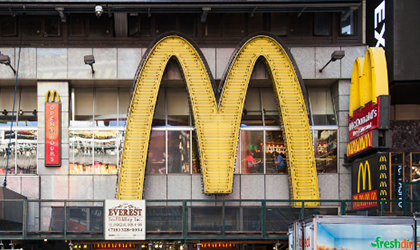
Michael Holmes, RSS Statistical Ambassador, writes: That is a difficult question to answer precisely, but we can arrive at a ballpark figure with some number crunching.
First, let us look at McDonald’s globally before focusing closer to home. In 2014, McDonald’s revenue was $27.4 billion, down 2% on the year before. That figure includes $18.2 billion in company-operated sales, and $9.2 billion in franchise revenue – fees and royalties paid, as a percentage of sales, to McDonald’s by the owners of restaurants not directly operated by the company. This might account for only one-third of McDonald’s total revenue, but 80% of the 36,000 McDonald’s restaurants worldwide are franchised – meaning we have no real way of knowing how much is spent directly by consumers in the vast majority of outlets. The remaining 20% of restaurants are operated by the company.
Perhaps the biggest challenge we face in answering this question is that McDonald’s projected sales growth – or revenue – is not known. The best we have to go on is that financial analysts are expecting the company to grow earnings at an average annual rate of 8% over the next five years. Revenues drive profits, but earnings can also be improved through cost-cutting measures. So, for the sake of argument, let us say that McDonald’s will want to grow revenues by 5% in 2016 – an ambitious target, perhaps, given that revenues for the first nine months of 2015 were down 5%.
As the company’s full 2015 results were not available at the time of writing, we will set aside this decrease for now and assume that revenue as of 31 December 2015 is the same as 2014: $27.4bn, and that McDonald’s will be looking to add 5% ($1.37bn) to that number by the end of 2016.
With the financials taken care of, we can now attempt to convert sales targets into burgers into calories, and provide an answer (of sorts) to the question: how many extra calories will UK and US diners need to consume? It is, however, important to note that our answer will depend on what McDonald’s plans to sell more of in order to hit its targets. If they are pushing sales of carrot sticks (34 calories) then this is going to have less of an impact on the waistline than if the additional revenue is made up entirely through sales of Big Macs (508 calories). But as the Big Mac is the mainstay of the McDonald’s menu, we will use this for our remaining examples and – to keep things simple – we will assume that McDonald’s only sells Big Macs.
In the UK the Big Mac sells for £2.88, with McDonald’s taking £1.4 billion in revenue in 2014. Measured purely in burgers, that works out at 486 million Big Macs. If McDonald’s was to increase its revenue by 5% this year (again, assuming that 2015’s revenue was also £1.4 billion) it would require the nation to consume an additional 24 million Big Macs, or 12 billion calories. This equates to an extra 191 calories for each of the UK’s 64 million residents, which may sound measly, but – assuming that there are 3,500 calories in a pound of fat – that is the equivalent of almost everyone in the town of Rotherham (population 257,000) putting on an extra stone in weight.
To apply the same logic to the USA, we find that McDonald’s revenue per capita is 15% lower there than in the UK, so each American would only need to consume an additional 139 calories a year for McDonald’s to boost their revenues by 5%.
Without access to McDonald’s detailed sales information, we are unable to tell the exact number of calories required. If the franchises are making large profits then our calculations might be on the low side; conversely if McDonald’s is selling lower-calorie foods, our estimates might be too high. However, by using some simplifying assumptions, we have been able to make a rough estimate of what the extra calories might be.
What is ‘Ask a statistician’?
A new regular column appearing in print and online in which we invite statisticians to answer burning questions put to them by members of the public. In the next issue, the Year 6 children of Milwards Primary School ask:
If current UK residents stopped having babies, how long would it take for the human population to drop to zero?
- Have an answer? Send it to significance@rss.org.uk, with the subject line “A statistician responds”.
- Have a question? Send it to significance@rss.org.uk, with the subject line “Ask a statistician”.




